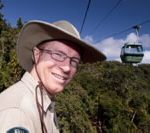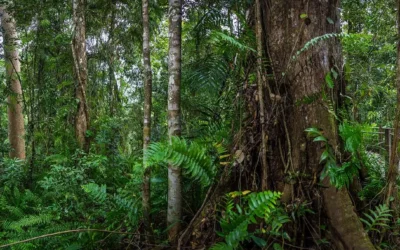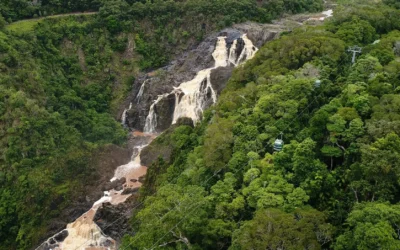Australian Brush Turkeys
Guests of the rainforest often expect to see plenty of wildlife during their Skyrail experience; after all the Wet Tropics World Heritage Tropical Rainforest area that Skyrail traverses is a biological haven containing endemic species that occur nowhere else in the world.
Skyrail’s Ranger guided tours at Red Peak Station introduce visitors to many aspects of the rainforests including the animals that are hard to find due to either being nocturnal, shy, well camouflaged – or often all three. Australian Brush Turkeys however are often an exception and Barron Falls Station is a likely location for sightings, with the birds more often seen there than any other Skyrail locale.
Although a common sight now (even in urban gardens as far south as Sydney), the species was believed to be on the brink of extinction during the days of the Great Depression of the 1930’s, coinciding with the construction of the first hydro-electric scheme at Barron Falls. Luckily however, it did not follow the same path as other less fortunate native animals during this period such as the now extinct Thylacine or Tasmanian Tiger.

Although referred to as a ‘turkey’ these birds are not directly related to common turkeys, but do share a similar appearance. Brush Turkeys are very ancient birds and belong to a group of birds called Megapodes (Greek for mega big/great pode foot) found in the Australasia and Pacific region. The Djabugay (local aboriginal people) name for this bird is Wawun and is import to their traditional culture for a number of reasons, including being a food source.
One of the most distinctive features of birds within the Megapode group is their incubation strategies for their eggs and level of care for their young. Megapodes don’t build conventional nests, plus they use external heat sources to incubate the eggs rather than the body heat of the parent. In the case of Brush Turkeys, the heat source is provided by microbes in the fermenting vegetation that is scraped into large mounds by the male birds. Unlike normal eggs, the eggs of Megapodes don’t need to be routinely rolled by the parent bird. The male bird is kept busy checking the mound temperature with his beak; adjusting it by removing or adding compost as required, attracting mates and continually increasing the size of his mound to make it more attractive to potential mates. The nesting mounds can be very large. Once the female lays the eggs she has no further commitment to the male or the offspring, which is typical for Megapodes, and the male must remain constantly vigilant to predators keen on stealing eggs. At Barron Falls Station we’ve previously seen a Brush Turkey chase a four-foot Goanna away from its nest!

Male birds with large mounds may successfully attract a number of females to mate with. Egg laying normally occurs in November prior to the wet season, when chicks hatch they benefit from the flush of new growth and fruit. After hatching, the chicks dig their way to the surface of the mound and run into the jungle. The young are fully independent and don’t receive any care from either parent. They can even fly within a few minutes of hatching, as they hatch with grown wing feathers.
Although relatively common in suitable habitats (indeed many gardeners complain about the birds scratching garden beds and raiding fruit and vegetables), the population is dependent on many factors. Young birds are rarely seen and are heavily preyed on by natural predators, namely snakes, rats and raptors. In urban situations additional threats are likely to have more significant impacts on localised, and increasingly isolated populations. These threats include fragmentation and loss of habitat due to urban development, vehicle strikes, dog and cat attacks and displacement of natural food plants by weeds and dumped green waste.
The role Brush Turkeys have in maintaining the rainforest is a very important one. They are primarily frugivores (fruit eaters) and spread seeds through the forest. By doing this they contribute to the diversity of the forest and influence the variety of animals that live there in the future due to the habitat they help create. They also help repair the forest after undergrowth has been affected by fire or cyclones as well as extending the rainforest edge into suitable habitat and lessening the effect of weed penetration.

By clearing the forest floor to create their nesting mounds and scratching the leaf litter to find food, they have a great effect on influencing what plant species germinate and survive on the forest floor. In the long run, this determines the composition of trees that form the canopy that in turn largely determine humidity, sunlight and temperature levels on the forest floor, and that has an effect on the whole forest. Brush Turkeys can also benefit plants, fungi and other organisms in a small area by concentrating the nutrients at the site of the mound.
What to do to make your garden more Brush Turkey friendly (and Brush Turkeys more friendly to your garden!)
Although Brush Turkeys, like many other wildlife, have the potential to cause grief for gardeners, there are a few tricks that can help us cohabit the same area. Given the range of contributing factors outlined previously, the need for conservation and understanding of their role and importance to the bush has never been more important.
Selection of plants: They have a strong preference for many fruits as opposed to leafy vegetables. Tall trees may be safer for fruit (these birds can still fly) but this provides a better opportunity for fruit bats that are hard to protect against.
Physical protection from crops: Netting or fencing can be used either permanently to enclose crops or temporarily as crops come into season.
Physical protection from scratching garden beds: Chicken wire or aviary mesh placed over garden beds enables plants to grow, water to pass through and is not attractive for the birds to scratch.
Knowledge of the species habits, preferences and movements: Which plants will be most affected will depend to some degree on the habit of the birds in your area. To be honest, research as well as trial and error are usually the best ways to find out.
Realising the benefits of Brush Turkeys and maximising this for your garden: The birds do have beneficial traits including removing some pests in the garden.
Relevance of this topic to the author: As well as living in the local rainforest trying to maintain gardens and fruiting trees with ever present Brush Turkeys, I am currently designing the landscaping at my new home. We don’t have Brush Turkeys but we do have a similar megapode, the Orange Footed Scrub Fowl. With a jungle creek corridor reserve, suburban homes and a busy road all in close proximity, we want to grow fruit and vegetables but also maintain all the wildlife in an increasingly urbanised environment. Our garden beds will be raised and fruit trees espaliered to make them easy to protect and harvest, with fifteen percent more cropping area designed than we require, so that produce losses to wildlife won’t be noticed. We will still maintain a ‘bush garden’ with native plants for wildlife and most importantly for the enjoyment of our family seeing and sharing our land with wildlife.
After reading this article we hope that you have a greater understanding and appreciation of how remarkable these birds are and the important role they play in shaping our natural environment – not to mention that they are not in the slightest way a type of ‘turkey’!
These Australian Tropical Rainforest facts brought to you by Skyrail Environmental Ranger Lance Neville.




